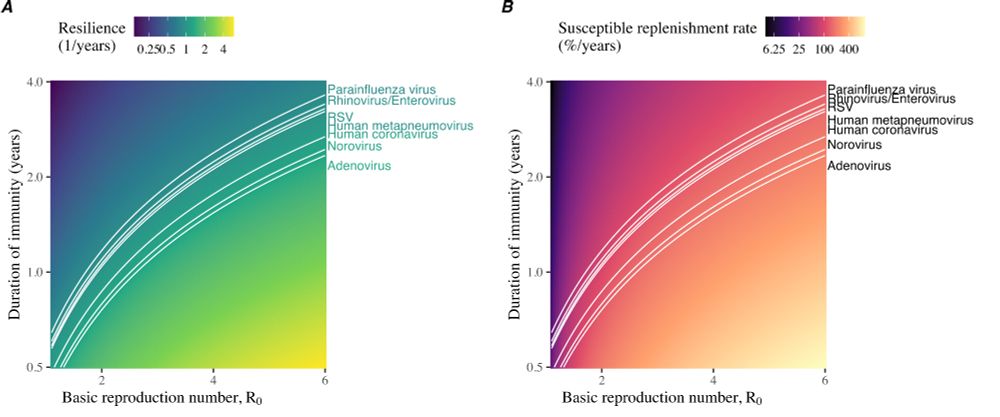
Sarah Cobey
@cobey.bsky.social
Professor at U. Chicago. Computational epidemiology, evolution, influenza, SARS-CoV-2, vaccines, and B cells. Infectious disease dynamics across scales.
Her net worth is dropping: paw.princeton.edu/article/mack...

Philanthropy, to the Rescue
Having donated more than $19 billion since 2019, MacKenzie Scott ’92 is setting a new model for philanthropy, not just in the scope, but also in the way she gives
paw.princeton.edu
November 4, 2025 at 12:08 PM
Her net worth is dropping: paw.princeton.edu/article/mack...
This doesn’t affect your main point, but I think the imprinting/“original antigenic sin” hypothesis, in which differences in mortality arise from differences in early influenza exposures by birth cohort, has much more support.
August 30, 2025 at 12:20 PM
This doesn’t affect your main point, but I think the imprinting/“original antigenic sin” hypothesis, in which differences in mortality arise from differences in early influenza exposures by birth cohort, has much more support.
Reposted by Sarah Cobey
But it does not *want* to do that. It has the personality and confidence of a 10x coder, and *absolutely lies to your face* to maintain the illusion.
It races to establish huge frameworks, call up parallel agents, and build you something that gives an output.
It races to establish huge frameworks, call up parallel agents, and build you something that gives an output.
August 12, 2025 at 12:47 PM
But it does not *want* to do that. It has the personality and confidence of a 10x coder, and *absolutely lies to your face* to maintain the illusion.
It races to establish huge frameworks, call up parallel agents, and build you something that gives an output.
It races to establish huge frameworks, call up parallel agents, and build you something that gives an output.
Coauthors are Bjarke Nielsen, Emily Howerton, and Bryan Grenfell. This work was mostly funded by the Life Sciences Research Foundation and NIH. Daniel is no longer on social media but is happy to answer any questions. [8/8]
June 23, 2025 at 9:07 PM
Coauthors are Bjarke Nielsen, Emily Howerton, and Bryan Grenfell. This work was mostly funded by the Life Sciences Research Foundation and NIH. Daniel is no longer on social media but is happy to answer any questions. [8/8]
Overall, quantifying pathogen resilience offers a new perspective on understanding how pathogens respond to both large and small perturbations. These insights have important implications for pathogen persistence, prediction, and model validation. [7/8]
June 23, 2025 at 9:07 PM
Overall, quantifying pathogen resilience offers a new perspective on understanding how pathogens respond to both large and small perturbations. These insights have important implications for pathogen persistence, prediction, and model validation. [7/8]
We've focused on resilience in the context of large perturbations. We also showed that resilience determines how sensitive a system is to smaller stochastic perturbations, with less resilient systems exhibiting greater deviations from deterministic trajectories under demographic stochasticity. [6/8]

June 23, 2025 at 9:07 PM
We've focused on resilience in the context of large perturbations. We also showed that resilience determines how sensitive a system is to smaller stochastic perturbations, with less resilient systems exhibiting greater deviations from deterministic trajectories under demographic stochasticity. [6/8]
What determines how resilient a pathogen is? It depends on the per-capita rate of replenishment of the susceptible population. Faster replenishment = more resilient dynamics, where the rate of replenishment depends on the duration of immunity and basic reproduction number (R0). [5/8]

June 23, 2025 at 9:07 PM
What determines how resilient a pathogen is? It depends on the per-capita rate of replenishment of the susceptible population. Faster replenishment = more resilient dynamics, where the rate of replenishment depends on the duration of immunity and basic reproduction number (R0). [5/8]
We estimated that common respiratory pathogens are much more resilient than vaccine-preventable infections, such as measles. Our predictions about pathogen return also closely match the observed deviations (or lack thereof) from the pre-COVID dynamics of respiratory pathogens. [4/8]

June 23, 2025 at 9:07 PM
We estimated that common respiratory pathogens are much more resilient than vaccine-preventable infections, such as measles. Our predictions about pathogen return also closely match the observed deviations (or lack thereof) from the pre-COVID dynamics of respiratory pathogens. [4/8]
We analyzed relevant time series data from Hong Kong, Canada, Korea, and the US. By quantifying the resilience of common respiratory pathogens, we could predict when each pathogen would eventually return to its pre-pandemic dynamics. [3/8]

June 23, 2025 at 9:07 PM
We analyzed relevant time series data from Hong Kong, Canada, Korea, and the US. By quantifying the resilience of common respiratory pathogens, we could predict when each pathogen would eventually return to its pre-pandemic dynamics. [3/8]
COVID-19 interventions disrupted the circulation of many pathogens. To understand if and when they might return to pre-pandemic patterns, we developed a framework for quantifying the rate of return to pre-pandemic patterns—a measure of pathogen resilience in a given host population. [2/8]

June 23, 2025 at 9:07 PM
COVID-19 interventions disrupted the circulation of many pathogens. To understand if and when they might return to pre-pandemic patterns, we developed a framework for quantifying the rate of return to pre-pandemic patterns—a measure of pathogen resilience in a given host population. [2/8]
Tbh I'm reading a review right now that completely misses some of our important contributions to a topic. Meanwhile it incorporates unnecessary jargon from some splashy articles in glam journals. In a dark reflective mood.
May 19, 2025 at 2:26 PM
Tbh I'm reading a review right now that completely misses some of our important contributions to a topic. Meanwhile it incorporates unnecessary jargon from some splashy articles in glam journals. In a dark reflective mood.
Unfortunately there's a risk people might not even notice your discovery unless it's in such a journal. Good work should speak for itself but it obviously doesn't fully. Sometimes I see publishing in 'higher impact' journals as a shortcut to having to give so many talks/wait for discovery.
May 19, 2025 at 2:21 PM
Unfortunately there's a risk people might not even notice your discovery unless it's in such a journal. Good work should speak for itself but it obviously doesn't fully. Sometimes I see publishing in 'higher impact' journals as a shortcut to having to give so many talks/wait for discovery.
This is such an important point. The timescales for lawsuits are much too slow to prevent the tremendous damage already occurring.
May 15, 2025 at 11:40 AM
This is such an important point. The timescales for lawsuits are much too slow to prevent the tremendous damage already occurring.
Reposted by Sarah Cobey
Yes, that’s exactly what they are doing. They are trying to hurt Harvard by destroying my research
May 15, 2025 at 11:32 AM
Yes, that’s exactly what they are doing. They are trying to hurt Harvard by destroying my research

